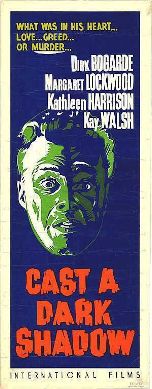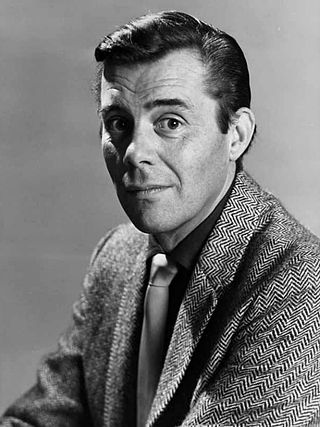
Sir Dirk Bogarde was an English actor, novelist and screenwriter. Initially a matinée idol in films such as Doctor in the House (1954) for the Rank Organisation, he later acted in art house films, evolving from "heartthrob to icon of edginess".

Jean Merilyn Simmons was a British actress and singer. One of J. Arthur Rank's "well-spoken young starlets," she appeared predominantly in films, beginning with those made in Britain during and after the Second World War, followed mainly by Hollywood films from 1950 onwards.

Margaret Mary Day Lockwood, CBE, was an English actress. One of Britain's most popular film stars of the 1930s and 1940s, her film appearances included The Lady Vanishes (1938), Night Train to Munich (1940), The Man in Grey (1943), and The Wicked Lady (1945). She was nominated for the BAFTA Award for Best British Actress for the 1955 film Cast a Dark Shadow. She also starred in the television series Justice (1971–74).

Doctor in the House is a 1954 British comedy film directed by Ralph Thomas and starring Kenneth More, Donald Sinden, Donald Houston and James Robertson Justice. It was produced by Betty Box. The screenplay, by Nicholas Phipps, Richard Gordon and Ronald Wilkinson, is based on the 1952 novel of the same name by Gordon, and follows a group of students through medical school.

The Greengage Summer is a 1961 British drama film directed by Lewis Gilbert and starring Kenneth More and Susannah York. It was based on the novel The Greengage Summer (1958) by Rumer Godden. Set in Épernay, in the Champagne region of France, it is the story of the transition of a teenage girl into womanhood.

The Shadow of the Cat is a 1961 British horror film directed by John Gilling and starring André Morell and Barbara Shelley. It was photographed in black-and-white by Arthur Grant. Produced by Hammer Film Productions, it was released in May 1961 on a double feature bill with Curse of the Werewolf.

Jean Kent, born Joan Mildred Field was an English film and television actress.

The Man in Grey is a 1943 British film melodrama made by Gainsborough Pictures; it is considered to be the first of a series of period costume dramas now known as the "Gainsborough melodramas". It was directed by Leslie Arliss and produced by Edward Black from a screenplay by Arliss and Margaret Kennedy that was adapted by Doreen Montgomery from the 1941 novel The Man in Grey by Eleanor Smith. The film's sets were designed by Walter Murton.

The Good Die Young is a 1954 British crime film directed by Lewis Gilbert and starring Laurence Harvey, Gloria Grahame, Joan Collins, Stanley Baker, Richard Basehart and John Ireland. It was made by Remus Films from a screenplay based on the 1953 novel of the same name by Richard Macaulay. It tells the story of four men in London with no criminal past whose marriages and finances are collapsing and, meeting in a pub, are tempted to redeem their situations by a robbery.

Sebastian is a 1968 British spy film directed by David Greene, produced by Michael Powell, Herbert Brodkin and Gerry Fisher, and distributed by Paramount Pictures. The motion picture is based on a story by Leo Marks, and Gerald Vaughan-Hughes wrote the screenplay.

Once Upon a Dream is a 1949 British comedy romance film directed by Ralph Thomas in his debut and starring Googie Withers, Griffith Jones, and Guy Middleton. It was a J. Arthur Rank presentation and a Sydney Box production, and was released through General Film Distributors Ltd. The film was made at the Lime Grove Studios with sets designed by the art director Cedric Dawe.

Doctor at Large is a 1957 British comedy film directed by Ralph Thomas starring Dirk Bogarde, Muriel Pavlow, Donald Sinden, James Robertson Justice and Shirley Eaton. It is the third of the seven films in the Doctor series, and is based on the 1955 novel of the same title by Richard Gordon.

The Woman in Question is a 1950 British murder mystery film directed by Anthony Asquith and starring Jean Kent, Dirk Bogarde and John McCallum. After a woman is murdered, the complex and very different ways in which she is seen by several people are examined. It was loosely adapted into the 1954 Indian film Andha Naal.

Dancing with Crime is a 1947 British film noir film directed by John Paddy Carstairs, starring Richard Attenborough, Barry K. Barnes and Sheila Sim. A man hunts down the killer of his lifelong friend.
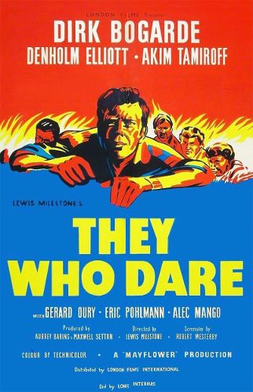
They Who Dare is a 1954 British Second World War war film directed by Lewis Milestone and starring Dirk Bogarde, Denholm Elliott and Akim Tamiroff. It was released by British Lion Films and in the United States by Allied Artists. The story is based on Operation Anglo that took place during World War II in the Dodecanese islands where special forces attempted to disrupt the Luftwaffe and Regia Aeronautica from threatening Allied forces in Egypt. The title of the film is a reference to the motto of the Special Air Service: "Who Dares Wins".
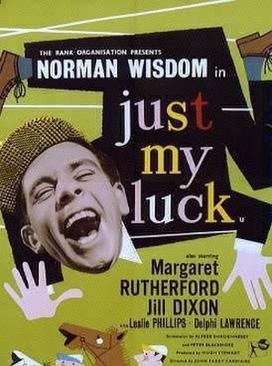
Just My Luck is a 1957 British sports comedy film directed by John Paddy Carstairs and starring Norman Wisdom, Margaret Rutherford, Jill Dixon and Leslie Phillips.

Dear Octopus is a 1943 British comedy film directed by Harold French and starring Margaret Lockwood, Michael Wilding and Celia Johnson. It is based on a 1938 play, Dear Octopus, written by Dodie Smith. It was also released as The Randolph Family.
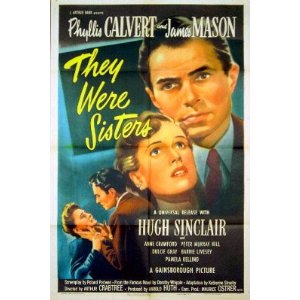
They Were Sisters is a 1945 British melodrama film directed by Arthur Crabtree for Gainsborough Pictures and starring Phyllis Calvert and James Mason. The film was produced by Harold Huth, with cinematography from Jack Cox and screenplay by Roland Pertwee. They Were Sisters is noted for its frank, unsparing depiction of marital abuse at a time when the subject was rarely discussed openly. It was one of the Gainsborough melodramas.
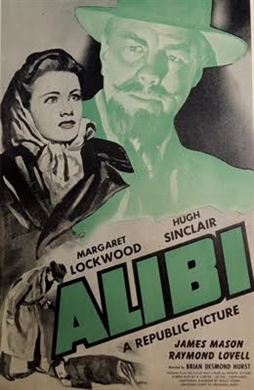
Alibi is a 1942 British mystery film directed by Brian Desmond Hurst and starring Margaret Lockwood, James Mason and Hugh Sinclair. It was based on the novel L'Alibi by Marcel Achard.

Esther Waters is a 1948 British drama film directed by Ian Dalrymple and Peter Proud and starring Kathleen Ryan, Dirk Bogarde, and Cyril Cusack. It is an adaptation of the 1894 novel Esther Waters by George Moore.
